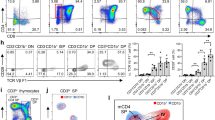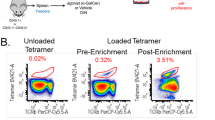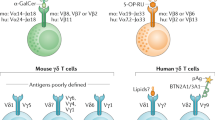Abstract
CD1d antigen presentation to natural killer T (NKT) cells expressing the semi-invariant T cell receptor Vα14Jα18 requires CD1d trafficking through endosomal compartments; however, the endosomal events remain undefined. We show that mice lacking the endosomal protease cathepsin L (catL) have greatly reduced numbers of Vα14+NK1.1+ T cells. In addition, catL expression in thymocytes is critical not only for selection of these cells in vivo but also for stimulation of Vα14+NK1.1+ T cells in vitro. CD1d cell-surface expression and intracellular localization appear normal in catL-deficient thymocytes, as does the lysosomal morphology; this implies a specific role for catL in regulating presentation of natural CD1d ligands mediating Vα14+NK1.1+ T cell selection. These data implicate lysosomal proteases as key regulators of not only classical major histocompatibility complex class II antigen presentation but also nonclassical CD1d presentation.
This is a preview of subscription content, access via your institution
Access options
Subscribe to this journal
Receive 12 print issues and online access
$209.00 per year
only $17.42 per issue
Buy this article
- Purchase on Springer Link
- Instant access to full article PDF
Prices may be subject to local taxes which are calculated during checkout





Similar content being viewed by others
References
Godfrey, D.I., Hammond, K.J., Poulton, L.D., Smyth, M.J. & Baxter, A.G. NKT cells: facts, functions and fallacies. Immunol. Today 21, 573–583 (2000).
Bendelac, A., Bonneville, M. & Kearney, J.F. Autoreactivity by design: innate B and T lymphocytes. Nature Rev. Immunol. 1, 177–186 (2001).
Bendelac, A. Positive selection of mouse NK1+ T cells by CD1-expressing cortical thymocytes. J. Exp. Med. 182, 2091–2096 (1995).
Coles, M.C. & Raulet, D.H. NK1.1+ T cells in the liver arise in the thymus and are selected by interactions with class I molecules on CD4+CD8+ cells. J. Immunol. 164, 2412–2418 (2000).
Castano, A.R. et al. Peptide binding and presentation by mouse CD1. Science 269, 223–226 (1995).
Zeng, Z. et al. Crystal structure of mouse CD1: An MHC-like fold with a large hydrophobic binding groove. Science 277, 339–345 (1997).
Lee, D.J., Abeyratne, A., Carson, D.A. & Corr, M. Induction of an antigen-specific, CD1-restricted cytotoxic T lymphocyte response in vivo. J. Exp. Med. 187, 433–438 (1998).
Joyce, S. et al. Natural ligand of mouse CD1d1: cellular glycosylphosphatidylinositol. Science 279, 1541–1544 (1998).
Sieling, P.A. et al. CD1-restricted T cell recognition of microbial lipoglycan antigens. Science 269, 227–230 (1995).
Chiu, Y.H. et al. Distinct subsets of CD1d-restricted T cells recognize self-antigens loaded in different cellular compartments. J. Exp. Med. 189, 103–110 (1999).
Chiu, Y.H. et al. Multiple defects in antigen presentation and T cell development by mice expressing cytoplasmic tail-truncated CD1d. Nature Immunol. 3, 55–60 (2002).
Roberts, T.J. et al. Recycling CD1d1 molecules present endogenous antigens processed in an endocytic compartment to NKT cells. J. Immunol. 168, 5409–5414 (2002).
Sugita, M. et al. Failure of trafficking and antigen presentation by CD1 in AP-3- deficient cells. Immunity 16, 697–706 (2002).
Prigozy, T.I. et al. Glycolipid antigen processing for presentation by CD1d molecules. Science 291, 664–667 (2001).
Nakagawa, T. et al. Cathepsin L: critical role in Ii degradation and CD4 T cell selection in the thymus. Science 280, 450–453 (1998).
Nakagawa, T.Y. et al. Impaired invariant chain degradation and antigen presentation and diminished collagen-induced arthritis in cathepsin S null mice. Immunity 10, 207–217 (1999).
Honey, K., Nakagawa, T., Peters, C. & Rudensky, A. Cathepsin L regulates CD4+ T cell selection independently of its effect on invariant chain: a role in the generation of positively selecting peptide ligands. J. Exp. Med. 195, 1349–1358 (2002).
Jayawardena-Wolf, J., Benlagha, K., Chiu, Y.H., Mehr, R. & Bendelac, A. CD1d endosomal trafficking is independently regulated by an intrinsic CD1d-encoded tyrosine motif and by the invariant chain. Immunity 15, 897–908 (2001).
Riese, R.J. et al. Regulation of CD1 function and NK1.1+ T cell selection and maturation by cathepsin S. Immunity 15, 909–919 (2001).
Kang, S.J. & Cresswell, P. Regulation of intracellular trafficking of human CD1d by association with MHC class II molecules. EMBO J. 21, 1650–1660 (2002).
Benlagha, K., Weiss, A., Beavis, A., Teyton, L. & Bendelac, A. In vivo identification of glycolipid antigen-specific T cells using fluorescent CD1d tetramers. J. Exp. Med. 191, 1895–1903 (2000).
Matsuda, J.L. et al. Tracking the response of natural killer T cells to a glycolipid antigen using CD1d tetramers. J. Exp. Med. 192, 741–754 (2000).
Benlagha, K., Kyin, T., Beavis, A., Teyton, L. & Bendelac, A. A thymic precursor to the NK T cell lineage. Science 296, 553–555 (2002).
Park, S.H. et al. The mouse CD1d-restricted repertoire is dominated by a few autoreactive T cell receptor families. J. Exp. Med. 193, 893–904 (2001).
Driessen, C. et al. Cathepsin S controls the trafficking and maturation of MHC class II molecules in dendritic cells. J. Cell Biol. 147, 775–790 (1999).
Shi, G.P. et al. Cathepsin S required for normal MHC class II peptide loading and germinal center development. Immunity 10, 197–206 (1999).
Stypmann, J. et al. Dilated cardiomyopathy in mice deficient for the lysosomal cysteine peptidase cathepsin L. Proc. Natl. Acad. Sci. USA 99, 6234–6239 (2002).
Schuchman, E.H. & Desnick, R. in The Metabolic and Molecular Basis of Inherited Disease edn. 8 Vol. 3 (eds. Scriver, C. R., Beaudet, A. L., Sly, W. S. & Valle, D.) 3589–3610 (McGraw-Hill Inc., New York, NY, 2001).
Gravel, R.A. et al. in The Metabolic and Molecular Basis of Inherited Disease edn. 8 Vol. 3 (eds. Scriver, C. R., Beaudet, A. L., Sly, W. S. & Valle, D.) 3827–3876 (McGraw-Hill Inc., New York, NY, 2001).
Dittmer, F. et al. Alternative mechanisms for trafficking of lysosomal enzymes in mannose 6-phosphate receptor-deficient mice are cell type-specific. J. Cell Sci. 112, 1591–1597 (1999).
Heylen, N. et al. Fibroblasts capture cathepsin D secreted by breast cancer cells: Possible role in the regulation of the invasive process. Int. J. Oncol. 20, 761–767 (2002).
Motyka, B. et al. Mannose 6-phosphate/insulin-like growth factor II receptor is a death receptor for granzyme B during cytotoxic T cell-induced apoptosis. Cell 103, 491–500 (2000).
Honey, K. et al. Cathepsin S regulates the expression of cathepsin L and the turnover of γ-interferon-inducible lysosomal thiol reductase in B lymphocytes. J. Biol. Chem. 276, 22573–22578 (2001).
Raposo, G., Kleijmeer, M.J., Posthuma, G., Slot, J.W. & Geuze, H.J. in Weirs Handbook of Experimental Immunology edn. 5 Vol. 4 (eds. Herzenberg, L. A., Weir, D. M. & Blackwell, C.) 208.1–208.11 (Blackwell Science Inc., Malden, MA, 1997).
Acknowledgements
Supported by the Howard Hughes Medical Institute (K. H. and A. R.) and the National Institute of Health (A. R. and A. B.), American Cancer Society (A. B.), NOW (M. J. K. grant 805-48-014) and the Leukemia and Lymphoma Society of America (K. B.). We thank G. Gillard, J. Griffith, C. Hsieh and P. Gough for excellent technical assistance, helpful discussions and critical review of the manuscript. R. Scriwanek and M. van Peski helped with the photography.
Author information
Authors and Affiliations
Corresponding author
Ethics declarations
Competing interests
The authors declare no competing financial interests.
Rights and permissions
About this article
Cite this article
Honey, K., Benlagha, K., Beers, C. et al. Thymocyte expression of cathepsin L is essential for NKT cell development. Nat Immunol 3, 1069–1074 (2002). https://doi.org/10.1038/ni844
Received:
Accepted:
Published:
Issue Date:
DOI: https://doi.org/10.1038/ni844
This article is cited by
-
CD1-mediated immune responses in mucosal tissues: molecular mechanisms underlying lipid antigen presentation system
Experimental & Molecular Medicine (2023)
-
Distinct gene expression patterns correlate with developmental and functional traits of iNKT subsets
Nature Communications (2016)
-
Cysteine cathepsin proteases: regulators of cancer progression and therapeutic response
Nature Reviews Cancer (2015)
-
A locus on mouse chromosome 13 inversely regulates CD1d expression and the development of invariant natural killer T-cells
Genes & Immunity (2015)
-
Control points in NKT-cell development
Nature Reviews Immunology (2007)



